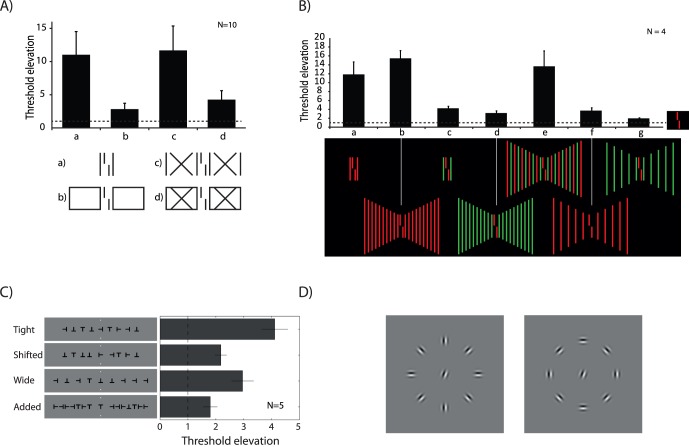Figure 3.
Crowding and uncrowding depend on many grouping cues (for demonstrations see Figure 5). (A) Good Gestalt. A vernier flanked by two lines of the same length yields high thresholds, that is, strong crowding (a). When the two lines are integrated in a rectangle, thresholds strongly decrease (b). Crossing the horizontal lines of the rectangle increases thresholds, similar to the single lines condition (c). Closing the rectangle by additional horizontal lines reduces crowding again (foveal vision: Sayim et al., 2010; peripheral vision: Manassi et al., 2012). The dashed line indicates performance for the unflanked vernier. (B) Pattern regularity. Thresholds for a red vernier flanked by single red lines (a) and 10 red lines (b) are high compared to the unflanked vernier condition (shown by the dashed line). When the flankers are green (c–d), thresholds are much lower. A grating with alternating red and green lines leads to high thresholds (e). The red (f) and green (g) parts of the alternating grating themselves crowd very little. Only when parts of the alternating grating are combined, do they form a pattern that leads to strong crowding (adapted from Manassi et al., 2012). (C) Spacing regularity. Observers discriminated the orientation of a central letter T. Threshold elevation is high when the spacing between flanking letters is small and regular (tight condition). Increasing the spacing between the target and the innermost flankers decreased crowding (shifted condition). Crowding increased when we increased the spacing between the remaining flankers creating a regular pattern (wide condition). Adding more flankers in the gaps between the flankers (added condition) decreased crowding again (modified from Saarela et al., 2010). (D) Contour integration. Gabor orientation discrimination is weak when the central Gabor is surrounded by radially arranged flankers. When the flankers make up a smooth contour, crowding is reduced (adapted from Livne & Sagi, 2007).

